Is Samsumg Galaxy Gear Ready for Prime Time?
See what you think…
Samsung’s smartwatch aims for the future but gets stuck in the past.
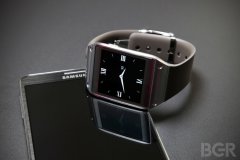 Top smartphone makers have a bit of a problem. They got so good at selling smartphones that there aren’t enough people left to buy them at the amazing pace the market has enjoyed over the past few years. The smartphone market is still monstrous, of course, but growth is key and growth is slowing. So for market leaders like Apple and Samsung, it’s time to look for the next big thing. According to a growing number of industry watchers, that “next big thing” is smartwatches and annual sales are already projected to explode into the hundreds of millions of units in the coming years. But are all these companies just trying to make fetch happen, or are wrist-worn devices like Samsung’s new Galaxy Gear smartwatch really the future of mobile computing?
Top smartphone makers have a bit of a problem. They got so good at selling smartphones that there aren’t enough people left to buy them at the amazing pace the market has enjoyed over the past few years. The smartphone market is still monstrous, of course, but growth is key and growth is slowing. So for market leaders like Apple and Samsung, it’s time to look for the next big thing. According to a growing number of industry watchers, that “next big thing” is smartwatches and annual sales are already projected to explode into the hundreds of millions of units in the coming years. But are all these companies just trying to make fetch happen, or are wrist-worn devices like Samsung’s new Galaxy Gear smartwatch really the future of mobile computing?
Smartwatches have been around for quite some time, but they have gone largely unnoticed by most consumers. So first and foremost, what is a smartwatch?
In the case of the Galaxy Gear and similar devices, a smartwatch is a smartphone companion device. It serves as an extension of your smartphone and saves you the trouble of having to pull a phone out of your pocket to perform certain functions. Yes that is the pitch, more or less, when it comes to smartwatches right now. You won’t have to pull your smartphone out of your pocket as often.
We’ll come back to that.
Despite the trouble vendors are having when it comes to pitching smartwatches, there is a bit more to them than that. The Galaxy Gear, for example, includes a camera and 4GB of storage, an in-built pedometer function, a stopwatch, media controls and more that allow the user to perform all kinds of functions right from his or her wrist. It also features voice calling capability so users can make and receive phone calls. But let’s start at the beginning.
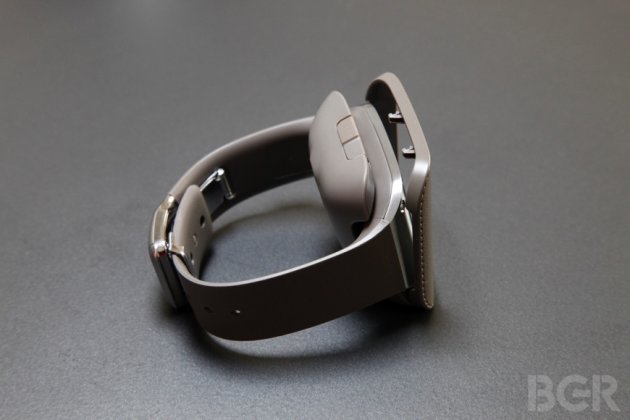
Setting up the Galaxy Gear smartwatch is remarkably simple. The device itself does not include integrated NFC but the charging cradle that comes with it does, and the watch is paired with the cradle out of the box. So to set up the Gear with your Galaxy Note 3, start by simply tapping the charging cradle to the back of your phone.
And yes, by the way, the Galaxy Gear only works with Samsung’s new Galaxy Note 3 phablet for the time being. If you’re hoping to get a Gear later this week and actually use it, prepare to spend $600 — $300 for the Gear and $300 for a new Note 3 on contract.
Tapping the cradle on the back of the Note 3 will launch a page that allows you to download Gear Manager, which is the app Samsung created to manage its smartwatch. Once Gear Manager is installed and launched, simply tap the cradle to the back of the Note 3 one more time and follow the on-screen instructions to pair the Galaxy Gear to your phone.
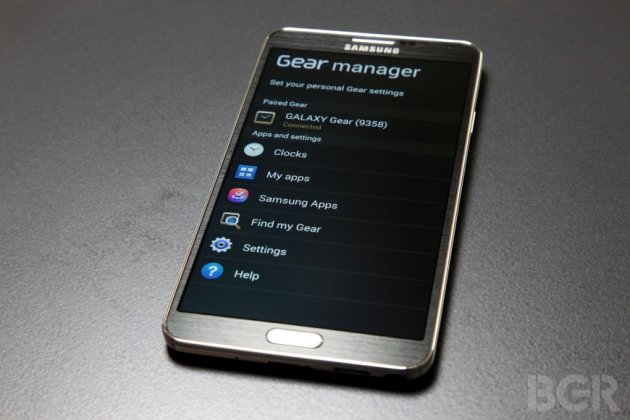
Gear Manager is very straight forward and it includes five main functions. The first is a “Clocks” section that allows you to choose between nine different analog and digital clock faces for telling the time on the Gear. They’re all fairly simple and attractive, and some digital options also provide additional items beneath the time such as shortcuts to open apps, a pedometer display so you see how many steps you’ve taken each time you look at the device, or even a weather icon set that shows the current conditions and temperature.
After Clocks is a “My apps” section that lists all of the installed apps on the Galaxy Gear and provides settings for each. This section also allows users to select from a list of additional featured apps created by Samsung and third parties such as Evernote, Path and LINE. Apps are installed from Samsung’s app store and are automatically available on the Gear once installed.
A “Samsung Apps” entry comes after My apps in Gear Manager, and this is simply a shortcut to the Galaxy Gear section of Samsung’s app store. Next comes “Find my Gear,” which causes the smartwatch to play an audible chime in the event you misplace the device.
Finally, a “Settings” entry provides general settings for the Gear and allows the user to toggle various features including Auto lock, which prevents you from having to enter your PIN or pattern to unlock the Note 3 as long as the Gear is connected, and Smart relay, which is a great feature that automatically displays relevant content on your phone when you pick it up after seeing a notification on your watch. So for example, if you get a text message on your Galaxy Gear and then pull your Note 3 out of your pocket, it will automatically open that text message on your phone.
The settings section also lets you pick and choose which compatible apps trigger notifications on the watch. Alarms, calendar alerts, emails and text messages are obvious options, but some third-party apps like Twitter and Facebook are supported as well.

Moving out of the Gear Manager app and on to the device itself, the Galaxy Gear’s first impression in terms of operation is not a good one.
Stepping back for a moment, the device itself is actually quite nice. It’s not terribly thick or bulky and the stainless steel face is a nice change from Samsung’s typical plastics. The rest of the Gear’s case is made of plastic though, and the strap is rubber.
The design will appeal to some more than others but compared to earlier smartwatches it’s pretty sleek. The 1.63-inch OLED display is typical top-notch Samsung quality and the exposed steel screws above and below it are a nice touch to break up the brushed stainless steel on the face.
On the other side of the fence, the camera bulging out of the front of the strap does a good job of ruining the device’s sleek look. Even worse than its appearance, the camera lens stares at people in front of you any time you look at the watch’s display, making it appear as though you’re always about to take someone’s picture. It makes people uncomfortable and the quality of images captured with the camera isn’t great, so it might have been a good idea to leave a camera off of the Gear.
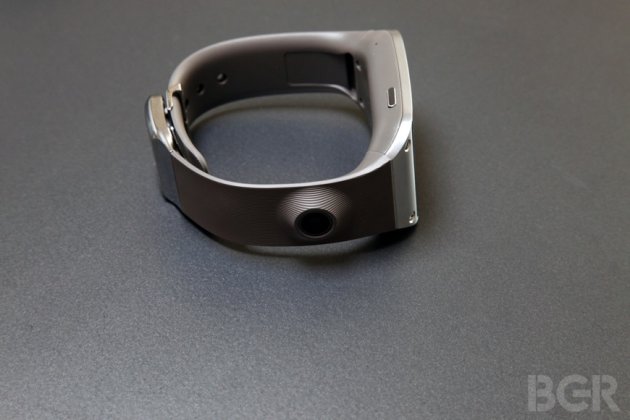
Back to that first impression. The Galaxy Gear can in fact be used to tell time on top of everything else. The display on the watch is turned off when it’s idle on your wrist, but it automatically turns on when you raise your arm up and look at the Gear. The problem, though, is that there is a delay of between 1 and 1.5 seconds from when you raise your arm up to check the time to when the display actually turns on.
This means that for a full second or more each and every time you check your watch, you’re staring at a blank display.
Also, the Galaxy Gear constantly thinks I am raising my arm to check the time while I’m driving, so every time I turn the steering wheel the display turns on. This is particularly annoying while driving at night. There is no ambient light sensor on the Galaxy Gear, which means the display does not dim automatically. I leave it fairly bright so that it’s visible in daylight so unless I adjust it manually each and every evening, it is extremely distracting when it turns on every time I turn the steering

When it comes to actually interacting with the watch, the interface is reasonably well designed and the screen is very responsive to taps and swipes, just as it was when I previewed the Galaxy last month. That said, this is a relatively new category and you will look very silly poking and swiping at your watch in public.
Samsung’s controls on the Gear are relatively straight forward. From the clock face view that serves as the device’s home screen, a swipe down on the display is a shortcut that opens the camera and a swipe up opens the phone dialer. Swiping from side to side moves through the various apps on the watch, as well as entries for a call log, notification history and settings.
Beyond that there are only three main gestures to learn. Swiping down from the top of the Galaxy Gear on any screen other than the clock face goes back one step. Double-tapping on any screen with two fingers opens a screen that shows the remaining charge and also provides quick access to volume and brightness controls. Finally, a long tap with two fingers on any screen opens up the app switcher, letting you quickly jump between open apps or swipe apps to the side to close them.

I found that getting notifications on the Galaxy Gear was a pretty solid experience. They hit the watch face instantly as soon as new messages or calls arrive on the phone, and the font on the watch is very legible so reading is no problem. Issues arise when it comes time to do anything about those notifications, however.
Controlling the Galaxy Gear with Samsung’s “S Voice” voice command feature is an awful, awful experience.
Using S Voice when anyone else is nearby is beyond embarrassing — my wife literally broke out laughing when I first began testing it — and talking to a watch is still uncomfortable even when you’re alone. Also, the actual voice Samsung uses for S Voice is very digital and unnatural. Worse still, S Voice is slow to open, slow to process speech, slow to issue commands, and painfully loud.
It’s just terrible.
You have no choice but to use S Voice when sending text messages and performing several other functions. Interacting with such a small display is not the same as interacting with a smartphone, of course, so swiping and tapping can only take you so far. Samsung had to use other means to allow for more complex interactions between the device and the user, and voice was the obvious answer. This is a key part of the user experience though, and beyond the inevitable discomfort when talking to a watch, S Voice’s poor performance makes using the Gear downright painful.
The voice recognition is reasonably accurate though, even while in a car with music on the radio thanks to the secondary mic for noise cancellation. So, at least there’s that.

You can also make and receive calls on the Galaxy Gear. The wearer’s voice is nice and clear for the person he or she is calling and the speaker on the bottom of the Galaxy Gear strap is pretty loud and somewhat clear. But… no. Using the Gear as a phone for voice calls is ridiculous and embarrassing.
Then again, holding the gigantic Galaxy Note 3 up to your face for voice calls isn’t much better.
In public, I can’t imagine a single person who would let his or her geek flag fly high enough to use the Gear as a phone. While driving a car, in-car Bluetooth systems and even standard Bluetooth headsets provide much better calling experiences. In other private situations, I just can’t envision a situation where voice calling on the Gear is terribly useful. The watch connects to your phone via Bluetooth, which means the user has to be within about 30 feet of the phone in order for the Gear to function. My advice: Pick up the phone.

Battery life is a pretty major concern when it comes to wearables and Samsung has been up front about the Galaxy Gear’s limitations in this area.
After fully charging the watch around 10:00 a.m. this past Saturday morning, using it all day and disconnecting it from the phone around midnight that night, the battery had about 35% left when I woke up the next morning. In other words, it can easily take you through a full day but cannot carry you much further. It absolutely must be charged every single night. Samsung said in meetings that the Gear will last one full day on a charge, so this was expected.
The charger setup is designed very poorly though, which makes the need to charge the Galaxy Gear daily even more painful. The charging connector is a plastic clam shell-like case that opens up and the Gear is then positioned inside. That piece is connected to a charger, but the port is on the wrong side on the back so the cable gets in the way when you dock the watch unless you slide the Gear over the lid of the charging cradle. This is awkward because it feels more natural to hold the cradle by the lid as you position the watch on the bottom part of the case.
It’s an all-around bad design.

A smarter approach might have been to make use of the four screws on the face of the watch and have them double as charger contacts. Then the user could have a stationary dock on his or her bed-side table or desk and just place the watch face down on the dock. The current design does allow for the face of the watch to be seen while the device is charging, but people will charge the device while they sleep at night so this is likely an unnecessary design element.
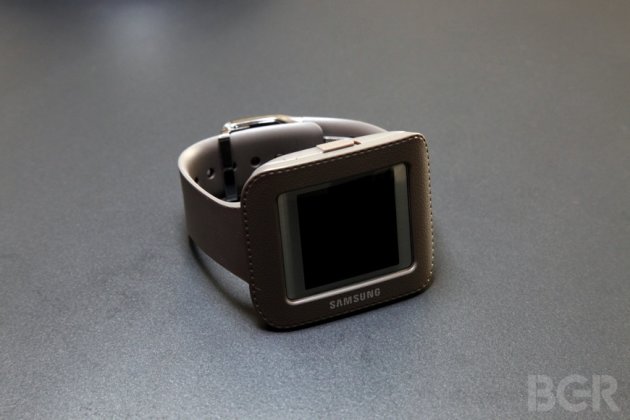
Wearables may or may not be the future of computing, but the Galaxy Gear makes envisioning that future very difficult.
Samsung is pitching the Gear as a smartphone companion device that is designed to make your life easier. It does not. In some cases the Gear adds conveniences to the mobile experience but they are minor at best and they come at too great a price: Another device to charge each day, an awful experience where voice controls are concerned, and a constant uncomfortable feeling shared by the user and those around him or her.
The device itself looks very nice compared to other smartwatches thanks to the sleek stainless steel case, the exposed screws and the beautiful AMOLED display. Samsung’s six color options are nice, providing more than enough choices to fit various styles. The Galaxy Gear is also built very well, with nary a jiggle or creak to be found.
But the Gear is a very tough sell for at least a dozen reasons. It’s awkward, S Voice is terrible, and any conveniences afforded by the device are far outnumbered by its numerous flaws and idiosyncrasies. The value proposition is also very weak right now and yet another barrier is the market Samsung’s new Gear competes in. Wearing a Galaxy Gear or any other smartwatch means not wearing a “real” watch, which is unthinkable to many people who put a great amount of time and effort into selecting their timepieces. Luckily there is plenty of room for new players in the $60 billion watch industry, but I doubt Samsung’s first effort will pull many people away from their current wristwatches of choice.
Personally, I can’t think of a feature set that would appeal to me enough that I would box up my watch collection and switch to a smartwatch. Perhaps some day Samsung and other smartwatch makers will show me some exciting features that make me at least consider the possibility, but today is certainly not that day. I would rather pull my phone out of my pocket and enjoy a terrific user experience each and every time than save myself the trouble with a half-baked companion device.
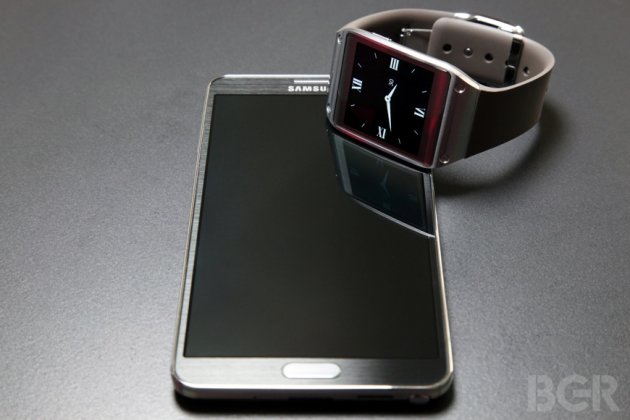
Samsung confirmed to BGR that it is already hard at work on a next-generation Galaxy Gear smartwatch, and it will use feedback from customers to help shape future devices. The company certainly has its work cut out for it because feedback will not be hard to come by.
In the end, the Galaxy Gear feels like a product that Samsung rushed to market in an effort to get a head start in the category many are calling the next big thing. Had rumors of Apple’s forthcoming “iWatch” not popped up late last year, the Galaxy Gear would almost certainly not exist. And if it did still exist, it wouldn’t exist as it does today.
Samsung’s first shot at the smartwatch category everyone is calling the future is hopelessly stuck in the past. It’s a tiny 1.63-inch window into a handful of basic smartphone functions. It brings nothing new to the table. It does not innovate or even try to. The Galaxy Gear is a “we were here first” device that feels like a half-baked response to an Apple product that doesn’t even exist.
If smartwatches are the future they will be nothing like Samsung’s Galaxy Gear.
By Zach Epstein | BGR News
